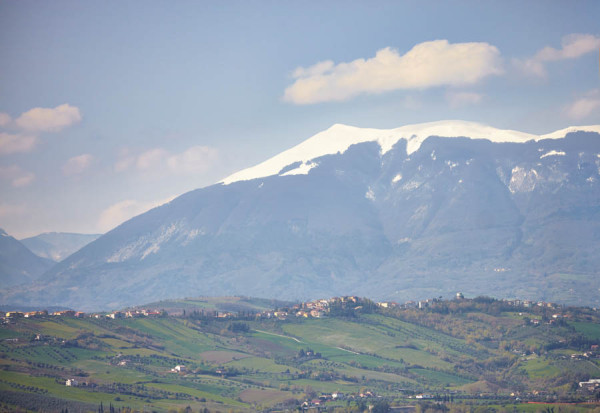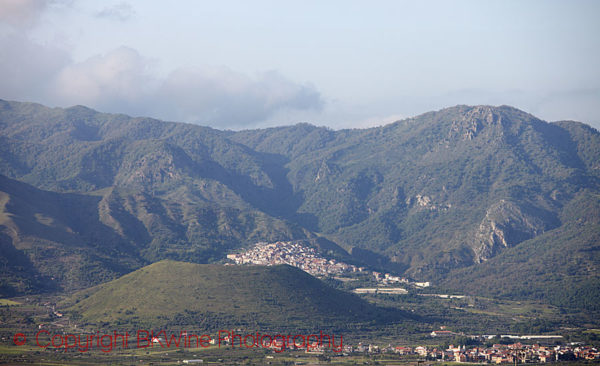When one brings up the concept of terroir—a French wine term used to describe a wine’s “sense of place”—you realize the importance that extraordinary vineyard soils have on producing truly exceptional wines.
This text is an opinion piece written by Igor Sill who is a winegrower in the region discussed in the text.
Mountain wineries flourished in the Napa Valley back in the late 19th century, before Prohibition put them out of business. There was a bit of newfound interest in the 1970s, but it wasn’t until the mid-1990s that existing wineries and vineyards were re-energized by new vintners and higher elevation mountain wines were rediscovered and revived to their past glory. There’s a discernible distinction to the grapes grown in Napa’s high elevation mountain areas.

NB: The picture does not come from Napa.
Mountain vineyards, usually some thousand feet or so in elevation, offer a different climatic rhythm and thus produce greater intensity of flavors and aromas. Only with height do you get the combination of clean, thin, cool mountain air which steadies the day’s temperatures, creating warmer days with full sun and cool nights. As elevation increases, sunlight becomes more concentrated, causing grapes to develop deeper pigments. They get more early sun because they are above the fog line, thus forcing grapes to mature and ripen slowly.
In the afternoon, the heat from the valley floor begins to drift up the hillsides. The grapes absorb more sun, then, close down at night, halting photosynthesis, sugar formation and acidity, locking in their structure and backbone while allowing them to ripen perfectly.
The mountains are more exposed to prevailing winds, giving more stress to the vines. The variation from warm to cool causes the vines to struggle, developing the acidity needed to produce such intense aromas, flavors, colors and tannins. You get much more depth, more notes, more balance, more structure and complexity from these climatic rhythms.
There is a discernible intensity to the fruit because they mature more slowly and age much more gracefully. There is depth and structure to the wines that you actually taste in these mountain grapes. One such higher elevation American Viticulture Area (AVA), Atlas Peak, provides shallow tufa topsoil that feature depth of flavors that are different from other Napa AVAs. This terroir offers a layer of nutrient-rich volcanic tufa soil ideal for farming cabernet sauvignon, merlot, cabernet franc and sangiovese. Its volcanic tufa consistency allows it to absorb water and retain moisture for long periods of time, thereby offering what exceptional grapes require: dry farming. Vines develop and produce best when stressed through dry farming. As the vine struggles to push roots deeper into the soil to scavenge more resources, ideal conditions develop for producing ultra-high quality grapes. Another benefit of making the vine struggle is that yields tend to be lower, which results in truly exceptional quality grapes.
Making things difficult for the vine, by restricting water supply, withholding fertilizers, making nutrients scarce, pruning it hard and crowding it with competing vine neighbors, excel it to another level. It senses that this is not the ideal place to be a grapevine; rather it devotes its self to reproducing, which for a vine means making exceptional, ultra-premium grapes. And, this is precisely what the finest vineyards do to produce phenomenal wines.
This volcanic loam also acts as an insulator, retaining the soil’s temperature consistent even if the air temperature fluctuates. Cabernet Sauvignon grapes thrive in this ashy volcanic soil, and Atlas Peak’s relatively high slopes offer an ideal growing elevation for these vines.
This volcanic soil acts like a solar panel, collecting and radiating solar heat throughout the day and into the night, well after the sun has set. The difference in temperature, known in the viticulture world as the diurnal temperature variation, is an important element for grapes as they develop both the right amount of acidity (from cool nights) and sweetness (from warm and sunny days). It is easy to see that there are certain places on the planet that are more perfect for growing grapes.

NB: the picture does not come from Napa.
The fact is that clay and limestone exists all over the world, so concerning oneself about why wine grown in Bordeaux’s soil is different than the one in Napa’s can be complicated—not to mention boring. But, if any terroir is going to be interesting, it’s the nutrient-rich volcanic soil these wines come from—particularly the Cabernets, which are complex, complicated, balanced, elegant, and much less tannic.
Every year, there seems a flurry of headlines about the health benefits of high-elevation red wine as if ripe berry flavors along with perfect structure weren’t reasons enough to seek out mountain wines. There is growing evidence that red wines grown at higher elevations possess greater levels of healthy antioxidant properties, gaining a reputation as an elixir of life.
A recent study by researchers at the Virginia Tech Carilion School discovered that resveratrol, a compound in the skin of red grapes and red wine have many of the neuroprotective benefits of a low-calorie diet and exercise, helping preserve muscle fibers and protecting connections between neurons from the negative effects of aging. The researchers found that resveratrol was able to shield neuromuscular junctions from damage as we age, essentially tapping into natural mechanisms to slow age-induced degeneration of neuronal circuits. The researchers plan to further study these neuroprotective effects by identifying the specific mechanism that enables resveratrol to protect synapses.
“Red wine has been demonstrated to have a beneficial effect on preventing heart disease. The mechanism of this benefit isn’t known yet, but we have been drinking wine for many centuries and, in addition to the joy it provides, scientists are working with vintners to better understand its health effects,” said Dr. David Agus, professor of Medicine & Engineering, University of Southern California. He is also an author of several books, including “The End of Illness,” “A Short Guide to a Long Life” and “The Lucky Years: How to thrive in the brave new world of health.”
Basically, plants synthesize the antioxidant resveratrol as a response to natural UV sunlight. Resveratrol is a naturally occurring polyphenol antioxidant that is found in some plants, like grapes.
The phenolic content in wine can be separated into two groups, flavonoids and non-flavonoids. Flavonoids contain anthocyanins and tannins which give the color and mouthfeel of the wine.
The non-flavonoids include the resveratrol and phenolic acids. These phenolic acids provide some of the most important elements in assessing a wine’s quality and are, very possibly, responsible for the beneficial health properties of red wines.
There are five American Viticulture Areas (AVAs) in Napa that can be described as mountain growing AVAs. On the western side of the valley are Diamond Mountain, Mount Veeder and Spring Mountain, and on the eastern side stands fabled Atlas Peak and, to its north, Howell Mountain.
Adjacent to Atlas Peak is Pritchard Hill, home to some of Napa’s great award-winning mountain wines including Dalla Valle, while further north is Mount St. Helena, home to Jericho Canyon with its spectacular, steeply terraced mountain vineyards.
Renowned and highly influential Bordeaux-based oenologist Michel Rolland said, “Growing these mountain grapes are far more difficult to farm and the growing season tends to be considerably longer. It’s much more difficult to plant, more difficult to establish the vines and they produce far lower yields, however, the end result is a grape expressing intensity of stellar quality as difficult growing conditions often lead to extraordinary wines.” Rolland maintains hundreds of vineyard clients across 13 countries around the globe.
Home to the most highly elevated and rocky volcanic mountainous landscape, Atlas Peak has been producing wines of renowned quality since 1870. The 11,400 acres (5000 hectars) of land that comprise the AVA include sangiovese and premium varietals used to create Bordeaux-style wines, such as cabernet sauvignon, merlot, cabernet franc, petite verdot and malbec.
Over the years, despite its rugged remoteness, the appellation has produced an abundance of wines acclaimed worldwide for their intense flavors and delicate, balanced tannins that have become the signature of Atlas Peak Mountain wines. It’s worth mentioning that mountain viticulture is a very expensive business when you have to remove tons of huge rocks to plant vines with different ripening times within rows which require many passes during harvest. Mountain wines tend to be produced in small quantities from land that is extremely expensive to farm, hence the reason that many of Napa’s expensive “cult” wines are from high elevations.
Wine is born of passion, evolving over time, offering a truly beautiful thing that speaks to us through heightened sensory emotions that can sometimes reflect wonderful universal mysteries in a surprising fashion, evoking one of life’s many unforgettable pleasures. I think the people who plant vineyards at higher elevations possess a different sort of inner motivation and optimism, perhaps more in harmony with Ernest Hemingway’s view that “wine is one of the most civilized and natural things of the world that has been brought to the greatest perfection.”
This text is an opinion piece written by Igor Sill who is a winegrower in the region discussed in the text.
Igor Sill farms a hillside cabernet sauvignon vineyard in St. Helena and a mountain vineyard on Atlas Peak Mountain in Napa. He’s a passionate wine lover, winemaker, writer.





